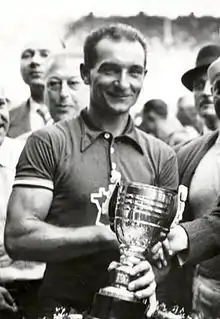Roger Lapébie
Roger Lapébie (pronounced [ʁɔ.ʒe la.pe.bi]; 16 January 1911 – 12 October 1996) was a French racing cyclist who won the 1937 Tour de France. In addition, Lapébie won the 1934 and 1937 editions of the Critérium National. He was born at Bayonne, Aquitaine, and died in Pessac.
 | |
| Personal information | |
|---|---|
| Full name | Roger Lapébie |
| Born | 16 January 1911 Bayonne, France |
| Died | 12 October 1996 (aged 85) Pessac, France |
| Team information | |
| Discipline | Road |
| Role | Rider |
| Professional teams | |
| 1932-1936 | La Française |
| 1937-1939 | Mercier |
| 1947 | Mercier |
| Major wins | |
Grand Tours
| |
Early career
Lapébie made his debut in the Tour de France in 1932, as a member of the French national team. He won one stage in that Tour, and was selected again in 1933; that year he did not win any stage.
In 1934, Lapébie again rode the Tour de France as part of the national team. He won five stages, and finished in third place in the general classification. He would have been a contender for the victory in the 1935 Tour, had it not been for his difficult relation with Henri Desgrange, the Tour director. In the 1935 Tour de France, Lapébie was not selected to be part of the French national team, but had to start as a French individual cyclist. In the Tour of 1936, he did not even start.
1937 Tour de France
In 1937, Desgrange had retired, and Lapébie was back. In the month before the Tour started, Lapébie had undergone surgery for a lumbar hernia, and there were doubts about his form.[1]
Lapébie won the 1937 Tour by riding 4,415 kilometers in 138 hours, 58 minutes and 31 seconds. His victory was controversial as he was the first rider to complete the race using a modern derailleur. This gave him the advantage of shifting gears without having to stop, dismount and flip the wheel as was customary of racing bicycles used at the time.[2] Lapébie was also known to accept outside assistance in violation of the rules and was at one point penalized 90 seconds by race commissaires.[3]
The advantages taken by Lapébie angered his Belgian rival, Sylvère Maes who had won the Tour the previous year. Maes had led the race through the Alps and Pyrenees but decided to quit in protest of Lapébie's tactics and derailleur use after the 16th stage to Bordeaux. Lapébie, in second place, took the yellow jersey in the absence of Maes and kept it until Paris. The victory delighted the French but angered the cycling-proud Belgians.
Following Lapébie's victory derailleurs became standard racing equipment in the Tour peloton.
Career achievements
Major results
- 1932
- Tour de France
- Winner stage 12
- 1933
- Circuit du Morbihan
 France National road race Championship
France National road race Championship- Paris-Saint-Etienne
- 1934
- Tour de France
- Winner stages 3, 4, 12, 14 and 15
- 3rd place overall classification
- Critérium International
- Paris–Nice:Winner stage 2 and 5B
- Paris-Saint-Etienne
- Paris-Vichy
- 1935
- Paris - Saint-Etienne
- Paris Routiers, Six Days
- Paris, Six Days
- 1937
- Critérium International
- Paris–Nice
- Tour de France
 Winner overall classification
Winner overall classification- Winner stages 9, 17C, 18A
- 1938
- Paris - Sedan
- 1939
- 1st stage Paris - Nice
Grand Tour results timeline
| 1932 | 1933 | 1934 | 1935 | 1936 | 1937 | |
|---|---|---|---|---|---|---|
| Giro d'Italia | DNE | DNE | DNE | DNE | DNE | DNE |
| Stages won | — | — | — | — | — | — |
| Mountains classification | — | — | — | — | — | — |
| Tour de France | 23 | 29 | 3 | DNF-12 | DNE | 1 |
| Stages won | 1 | 0 | 5 | 0 | — | 3 |
| Mountains classification | NR | NR | NR | NR | — | NR |
| Vuelta a España | N/A | N/A | N/A | DNE | DNE | N/A |
| Stages won | — | — | ||||
| Mountains classification | — | — |
| 1 | Winner |
| 2–3 | Top three-finish |
| 4–10 | Top ten-finish |
| 11– | Other finish |
| DNE | Did Not Enter |
| DNF-x | Did Not Finish (retired on stage x) |
| DNS-x | Did Not Start (no started on stage x) |
| HD | Finished outside time limit (occurred on stage x) |
| DSQ | Disqualified |
| N/A | Race/classification not held |
| NR | Not Ranked in this classification |
References
- McGann, Bill; McGann, Carol (2006). The Story of the Tour De France. dog ear publishing. pp. 132–139. ISBN 978-1-59858-180-5. Retrieved 2010-01-15.
- History of the Tour de France: 1920–1939 - Les Forcats de la Route by Mitch Mueller
- The Official Tour de France Centennial 1903-2003, pg. 124
External links
- Roger Lapébie at Cycling Archives